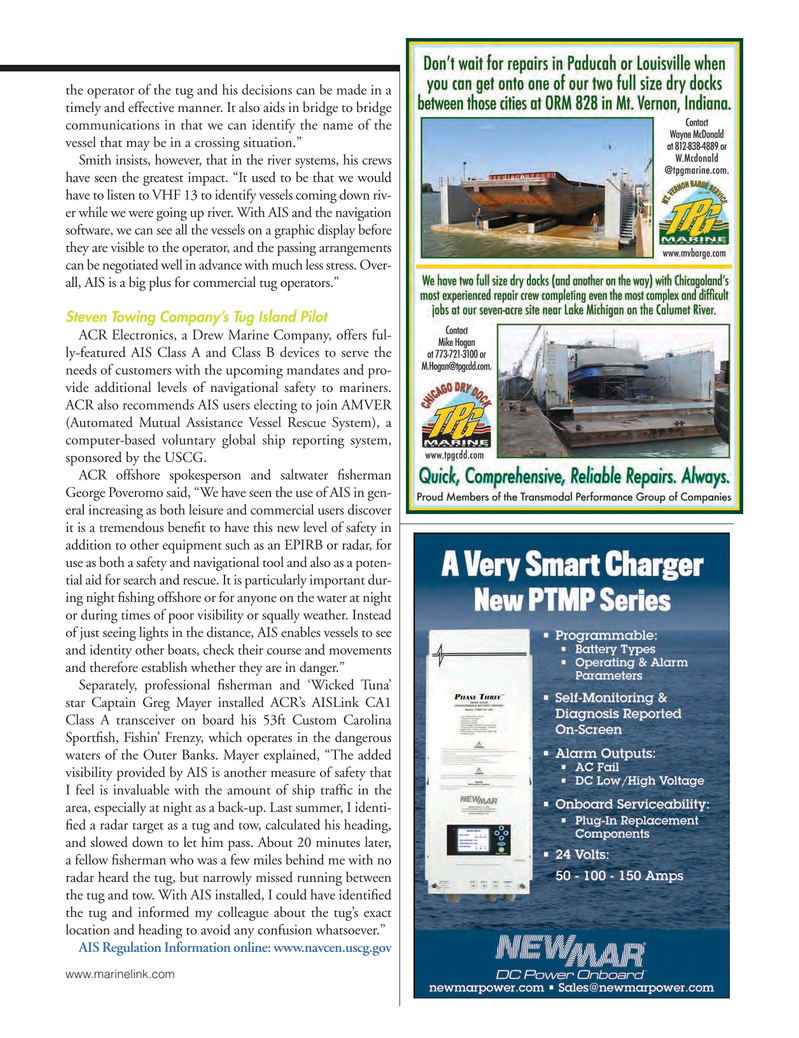
Page 43: of Marine News Magazine (April 2016)
Boatbuilding: Construction & Repair
Read this page in Pdf, Flash or Html5 edition of April 2016 Marine News Magazine
the operator of the tug and his decisions can be made in a timely and effective manner. It also aids in bridge to bridge communications in that we can identify the name of the vessel that may be in a crossing situation.”
Smith insists, however, that in the river systems, his crews have seen the greatest impact. “It used to be that we would have to listen to VHF 13 to identify vessels coming down riv- er while we were going up river. With AIS and the navigation software, we can see all the vessels on a graphic display before they are visible to the operator, and the passing arrangements can be negotiated well in advance with much less stress. Over- all, AIS is a big plus for commercial tug operators.”
Steven Towing Company’s Tug Island Pilot
ACR Electronics, a Drew Marine Company, offers ful- ly-featured AIS Class A and Class B devices to serve the needs of customers with the upcoming mandates and pro- vide additional levels of navigational safety to mariners.
ACR also recommends AIS users electing to join AMVER (Automated Mutual Assistance Vessel Rescue System), a computer-based voluntary global ship reporting system, sponsored by the USCG.
ACR offshore spokesperson and saltwater ? sherman
George Poveromo said, “We have seen the use of AIS in gen- eral increasing as both leisure and commercial users discover it is a tremendous bene? t to have this new level of safety in addition to other equipment such as an EPIRB or radar, for use as both a safety and navigational tool and also as a poten- tial aid for search and rescue. It is particularly important dur- ing night ? shing offshore or for anyone on the water at night or during times of poor visibility or squally weather. Instead of just seeing lights in the distance, AIS enables vessels to see and identity other boats, check their course and movements and therefore establish whether they are in danger.”
Separately, professional ? sherman and ‘Wicked Tuna’ star Captain Greg Mayer installed ACR’s AISLink CA1
Class A transceiver on board his 53ft Custom Carolina
Sport? sh, Fishin’ Frenzy, which operates in the dangerous waters of the Outer Banks. Mayer explained, “The added visibility provided by AIS is another measure of safety that
I feel is invaluable with the amount of ship traf? c in the area, especially at night as a back-up. Last summer, I identi- ? ed a radar target as a tug and tow, calculated his heading, and slowed down to let him pass. About 20 minutes later, a fellow ? sherman who was a few miles behind me with no radar heard the tug, but narrowly missed running between the tug and tow. With AIS installed, I could have identi? ed the tug and informed my colleague about the tug’s exact location and heading to avoid any confusion whatsoever.”
AIS Regulation Information online: www.navcen.uscg.gov www.marinelink.com
MN April16 Layout 32-49.indd 43 3/18/2016 10:38:30 AM

 42
42

 44
44
